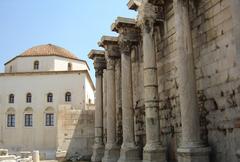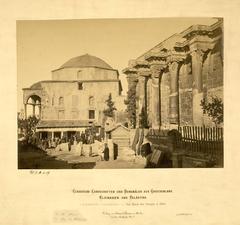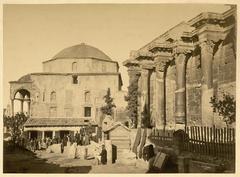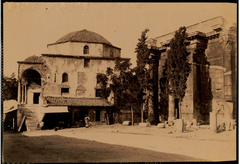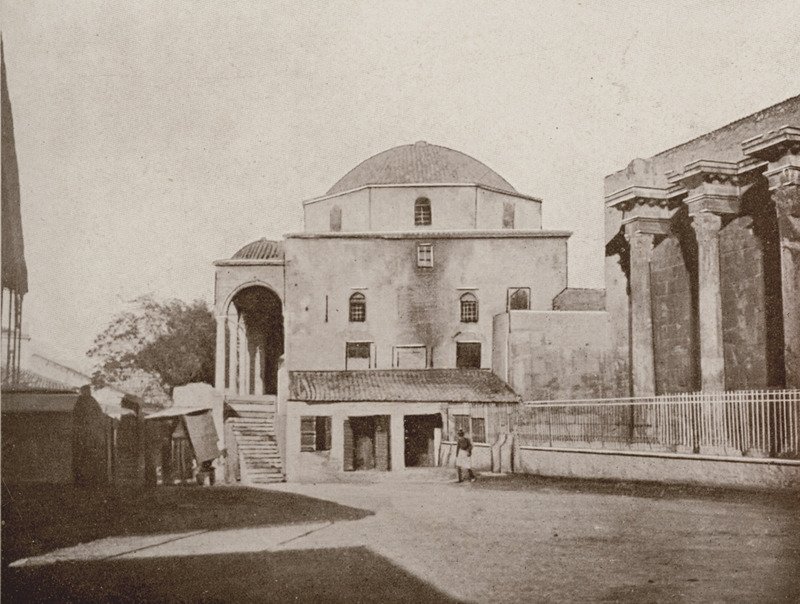
Tzistarakis Mosque Athens, Greece: Visiting Hours, Tickets, and Historical Guide
Date: 14/06/2025
Introduction
Located in the heart of Athens’ lively Monastiraki Square, the Tzistarakis Mosque stands as a vivid testament to the city’s layered history. Blending Ottoman heritage with ancient and modern influences, the mosque is not only an architectural landmark but also a focal point for understanding Athens’ multicultural past and present (Athens Historical Sites). Today, it operates as an annex of the Museum of Greek Folk Art and houses significant collections of ceramics and folk artifacts. This guide offers a detailed overview of its history, architecture, visiting information, and travel tips to help you make the most of your visit.
Table of Contents
- Historical Background
- Architectural Features
- Visitor Information
- Nearby Attractions
- Frequently Asked Questions (FAQ)
- Travel Tips and Summary
- References
Historical Background
Construction and Origins
Tzistarakis Mosque was built in 1759 by Mustapha Agha Tzistarakis, the Ottoman governor (voevoda) of Athens. The mosque was intended to serve the city’s Muslim community and to leave a legacy comparable to the great builders of the past (Wikipedia; Spotting History). Strategically positioned at what is now Monastiraki Square, then the bustling Bazaar, it quickly became a prominent religious and social center during Ottoman rule (Greek Reporter).
The Use of Ancient Materials and the “Cursed Mosque” Legend
A defining controversy surrounds the mosque’s construction: Tzistarakis ordered the destruction of an ancient column, likely from Hadrian’s Library or the Temple of Olympian Zeus, to produce lime for the mosque’s mortar (Athens by Locals; Middle East Eye). This act violated Ottoman law and local superstitions. Soon after, a plague struck Athens, fueling the legend that the mosque was cursed. Tzistarakis was subsequently dismissed, and local lore claims he met a violent end (Iakovidis, Medium).
Role During and After the Greek War of Independence
Following the Greek War of Independence (1821), the mosque ceased religious functions and was repurposed for various uses: as an assembly hall, barracks, prison, and event space. The minaret was destroyed between 1839 and 1843, reflecting the changing identity of the city (Spotting History; Greek Reporter).
Restoration and Museum Era
The mosque deteriorated in the early 20th century but was restored in 1915 and converted into a museum. Since 1975, it has functioned as an annex of the Museum of Greek Folk Art, displaying collections that include Greek, Cypriot, and Turkish ceramics (Museum of Greek Folk Art). In 1966, it briefly returned to religious use when King Saud of Saudi Arabia prayed there (Middle East Eye).
Architectural Features
Tzistarakis Mosque is a fine example of Ottoman religious architecture in Greece. Its key features include:
- Central Dome and Octagonal Drum: The mosque’s large hemispherical dome, supported by an octagonal drum, dominates the structure and is visible from across Monastiraki Square (Spotting History).
- Portico with Three Arches: The western façade features a portico with three elegant arches supported by columns, creating a grand entrance.
- Founder’s Inscription: Above the main door is an inscription attributing the building to Mustapha Agha Tzistarakis.
- Mihrab: Inside, the original prayer niche (mihrab) remains, though the space is now largely dedicated to museum exhibits.
- Use of Ancient Materials: The mosque incorporates spolia (reused ancient building materials), physically linking it to Athens’ classical heritage.
- Absence of Minaret: The original minaret was destroyed, a visible reminder of the city’s transformation since Ottoman times.
The interior, once richly decorated, now houses displays of folk ceramics and artifacts curated by the Museum of Greek Folk Art. Natural light from the dome’s windows creates a warm atmosphere, especially in the late afternoon.
Visitor Information
Visiting Hours and Ticket Prices
- Opening Hours: Tuesday to Sunday, 9:00 AM – 5:00 PM. Closed on Mondays and major public holidays.
- Tickets: Admission is included with the Museum of Greek Folk Art ticket.
- Standard: €4–€6 (confirm current price at the official museum site)
- Reduced (students, seniors): €2–€3
- Free entry for children under 12, Athens residents, national holidays, and the first Sunday of each month
(Museum of Greek Folk Art; Museum of Modern Greek Culture)
Accessibility
- Ramps at the entrance provide wheelchair access to most areas, though some uneven surfaces remain due to the mosque’s historic nature.
- Assistance is available upon request.
- Multi-language audio guides and information leaflets are offered.
Getting There
- Metro: Monastiraki Station (Lines 1 and 3) – less than a 2-minute walk.
- Bus: Several routes stop near Monastiraki Square.
- Walking: Easily accessible from Plaka, Syntagma Square, and other city-center locations.
Guided Tours and Events
- Guided Tours: Daily at 11:00 AM and 3:00 PM, focusing on the mosque’s history and Athens during the Ottoman era. Advance booking is recommended.
- Special Events: The mosque regularly hosts cultural events, temporary exhibitions, and traditional music performances, especially during summer festivals.
Best Times and Photographic Spots
- Best Time to Visit: Early morning or late afternoon for optimal lighting and fewer crowds.
- Photography: Allowed inside and outside (no flash or tripods). The best shot of the mosque’s dome is from Monastiraki Square with the Acropolis in the background.
Nearby Attractions
The mosque’s central location makes it ideal for combining with other major Athens sights:
- Hadrian’s Library: Adjacent to the mosque.
- Ancient Agora: 5-minute walk.
- Plaka Neighborhood: Within easy walking distance.
- The Acropolis Museum: 10-minute walk.
- Monastiraki Flea Market: Right outside the mosque.
Frequently Asked Questions (FAQ)
Q: What are the Tzistarakis Mosque visiting hours?
A: Tuesday to Sunday, 9:00 AM to 5:00 PM; closed Mondays and public holidays.
Q: How much do tickets cost?
A: Standard admission €4–€6; reduced €2–€3; free for children under 12, Athens residents, national holidays, and the first Sunday of each month.
Q: Is the mosque wheelchair accessible?
A: Yes, the main areas are accessible; assistance is available.
Q: Are guided tours available?
A: Yes, daily at 11:00 AM and 3:00 PM; advance booking recommended.
Q: Can I take photos inside?
A: Yes, but flash and tripods are not permitted.
Q: Are refreshments nearby?
A: Monastiraki Square and Plaka offer numerous cafes and restaurants.
Travel Tips and Summary
- Combine Your Visit: Plan your mosque visit alongside Hadrian’s Library, Ancient Agora, and the lively Monastiraki Flea Market for a comprehensive historical experience.
- Check for Exhibitions: The mosque’s museum annex hosts rotating exhibitions—consult the museum website for current events.
- Dress Comfortably: There is no strict dress code, but modest attire is appreciated. Wear comfortable shoes for walking the area’s cobblestone streets.
- Respect the Space: While not an active mosque, it remains a significant cultural and historical monument.
The Tzistarakis Mosque offers a rare opportunity to explore Athens’ Ottoman heritage in a single, accessible location. Its rich history, distinctive architecture, and role as a museum make it a rewarding destination for history enthusiasts and casual visitors alike (Athens Historical Sites; Touristlink).
References
- Tzistarakis Mosque Visiting Hours, Tickets & History | Athens Historical Sites
- Athens by Locals, Monastiraki in Athens
- Iakovidis, The cursed mosque of Athens, Medium
- Greek Reporter, Ancient history in Athens’ Monastiraki
- Touristlink, Tzistarakis Mosque Overview
- Museum of Greek Folk Art official website
- Middle East Eye, Five Ottoman sites to visit in Greece
- Museum of Modern Greek Culture official website
Ready to explore the Tzistarakis Mosque and Athens’ unique history?
Download the Audiala app for guided tours, updates, and insider tips.

